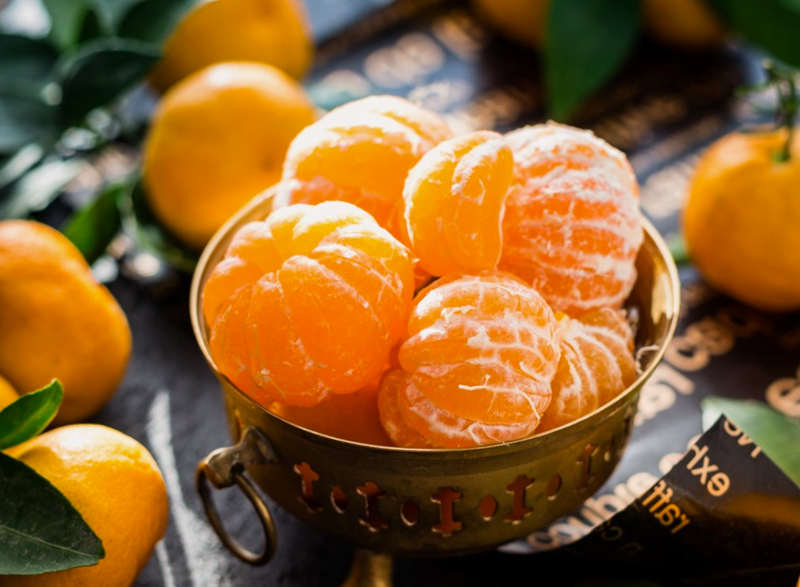Oranges are another zesty staple in the kitchen, a perfect perk-me-up and a helpful cooking condiment. While their colour and general round silhouette may compel us to gloss over the differences between types, this family of fruits is far from synonymous. With over 400 varieties of cultivars, orange trees were the most cultivated fruit tree in the world as of 1987. With that, let’s delve into this segment of our Produce explained series, into the 8 types of oranges we may know, to develop a more discerning eye for these beauties that lie along the aisles of our supermarkets.

1. Navel orange

What it is:
The Navel orange is the most popular type of orange, the one you’re probably snacking on. As its moniker goes, it resembles a human navel, with a circular hole on the bottom stem end. This bright orange lies on the larger side, with thicker skin that’s easy to peel for consumption, and is in season from November to June.
What makes it unique:
Its pale yellow to orange flesh is tender and juicy. You’ll probably notice that it’s divided into 10 to 12 segments by thin membranes. As a seedless orange, it’s easy to snack on, but its slight bitterness makes it less appealing for orange juice. The juice of navel oranges contain an antioxidant known as limonin, which causes the juice to turn bitter or sour after about 30 minutes of exposure to air. Heath-benefits wise, they’re an excellent source of Vitamin C, dietary fibre, and thiamin.
What it’s used for:
The inviting flavour and lack of seeds make navel oranges a popular choice for snacking and in salads. Their zest can be used in baking as they lend a bright tart-sweetness to the dish. They also pair well with other fruits like strawberries, bananas, and coconut.
Price: From S$3.20 per pack
2. Valencia orange

What it is:
In spite of its Spanish namesake, Valencia oranges were created in California in the mid-19th century. Medium to large in size, they have a bright orange-coloured rine which is thin and smooth. They are mostly harvested from March through July, but continue to ripen after harvest. The longer they ripen, the sweeter they taste. Also, sometimes, the Valencia orange may go through a regreening process, which is when the fruit reabsorbs chlorophyll, giving it hues of green even though it is fully ripe. Thankfully though, regreening does not affect its flavour.
What makes it unique:
The Valencia orange is slightly more tart than the navel orange. They contain a few seeds, ranging from zero to nine per fruit. However, it’s known for its remarkable juiciness, and together with a near-seedless pulp, this orange is ideal for juicing.
What it’s used for:
It’s used to make juice, syrups, cocktails, and marinades. It can also be eaten raw or in a salad.
Price: From S$2.50 per pack
3. Blood orange

What it is:
Not all oranges are named after the same colour, and the Blood orange is the epitome of this, embodying its ruby, almost blood-coloured flesh. This medium-sized fruit has thick orange skin, and is lauded as one of the most aromatic oranges in the family.
What makes it unique:
There are three main types of blood oranges: Moro, Sanguinello, and Tarocco—ranging from tart to sweet, respectively. Blood oranges are very juicy, making them useful as sauces and marmalade. Interestingly, their red colour is derived from a pigment called anthocyanin, which is not usually present in citrus, but common in other red fruits and flowers.
What it’s used for:
Their beautiful and vibrant crimson colour makes them appealing as a garnish on desserts and cakes. These oranges are very versatile, most often utilised for their sweet flesh and juice, in both sweet and savoury preparations, raw or cooked. Their juice is used in cocktails, syrups and marinades, and they are often paired with other citrus fruits, fresh herbs, soft cheeses, seafood, and more.
Price: From S$5 per pack
4. Cara Cara orange

What it is:
The Cara Cara orange has a common moniker of “the pink navel”, as it’s a natural mutation discovered on a Washington Navel orange tree. Boasting a rich and deep salmon colour, its size varies, from small to medium and large. It is available from January to May.
What makes it unique:
Cara Cara oranges are succulent and inviting, in both their appearance and taste. Their beautiful flesh is reputed for being refreshingly sweet, seedless and not acerbic. Their taste carries hints of fruits, like the blood and navel orange, and sometimes even berries and cherries. Adding to the list, some may taste the mix of tangerine and grapefruit in it. This orange owes its pink flesh to the carotenoid, lycopene, which can fight against certain diseases.
What it’s used for:
Holding an ideal balance of acidity and sweetness, these oranges are great for eating fresh, made into jams and sauces, and for baking and sautéing. Ideal in both savoury and sweet preparations, they pair well with avocados, lettuces, fresh herbs, strong cheeses, and more.
Price: From S$5.50 per pack
5. Honey Murcott

What it is:
The Honey Murcott is a type of Mandarin orange. While most of us may believe a Mandarin orange to be a subset of oranges, news flash: mandarin oranges technically aren’t oranges at all. They are a group of citrus fruits that are small with loose skin and a relatively flattened look. Oranges are actually the hybrids of mandarins and pomelos.
The Honey Murcott is about 9cm wide, imbued with yellow-orange, glossy, and smooth skin that is thin and tight. It supposedly originated from the U.S.
What makes it unique:
This Mandarin orange is very juicy with few seeds and moderately sweet with low acidity. Unlike its namesake, its flavour has no resemblance to honey, and is rather, added for marketing purposes.
What it’s used for:
It can be eaten fresh and is a common ingredient in desserts, cocktails and cakes.
Price: From S$7.49 per pack
6. Ponkan

What it is:
Once thought to be a pure Mandarin, the Ponkan is actually a citrus hybrid of the mandarin orange and pomelo. This large and round fruit is reputed for its smooth skin. It is one of the oldest known and most widely grown mandarin varieties and is available in the late fall through mid-winter.
What makes it unique:
Ponkans are easy to peel, with puffy skin and loose rinds. Their tender and juicy flesh easily segments, and they also have few seeds, making them a great and appetising snack. As they’re very sweet and succulent, balanced with low acidity, they can be cloying if you have more than one at one go.
What it’s used for:
Other than being eaten raw, Ponkan tangerines can also be added to green or fruit salads and salsas. The juice is ideal for beverages, marinades, dressings, glazes, desserts, and more.
Price: Not available during this season
7. Tangerine

What it is:
The Tangerine is a type of Mandarin orange that’s generally small and flatter than most other citrus fruits. Its dark orange skin rests as a loose encasement for the flesh, making it easy to peel. They are available from beginning to late winter and is actually the second-most produced citrus fruit in the world.
What makes it unique:
The flesh of tangerine is divided into eight to ten segments, and is extremely sweet and bursting with juice. It lacks the usual acidity of most citrus fruits. It is low in calories but high in healthy nutrients like Vitamin A, calcium, potassium, and fibre. Also, it contains more Vitamin C than your typical orange, making it a great choice against premature skin ageing.
What it’s used for:
Easy to peel, tangerines are go-to snacks for travelling and school lunches for children. They can also be enjoyed in baked goods, jams and desserts, and their skin can be candied too.
Price: From S$5.50 per pack
8. Clementine

What it is:
Also known as Halo mandarin, the Clementine is a hybrid mandarin variety. It’s a general descriptor that encompasses over fifteen hybrid varieties that are closely related to similar characteristics. They are small to medium fruits with a flat apex, giving them a more oval shape unlike the rest of the oranges. The clementine has thin and glossy skin that’s bright orange to vermillion. It is grown worldwide for year-round availability, forming a stronghold in the global citrus market.
What makes it unique:
It is loved for its easy-to-peel skin and small size. With a balanced sugar level and tartness, its flesh is sweet and subtly tangy, while emanating an aromatic, fruity and floral scent. Great while consumed fresh, the clementine is ranked high in children’s snacks and as travel snacks. They are high in Vitamin C and provide beta-carotene, the coloured pigment within the flesh that is converted into Vitamin A in the body.
What it’s used for:
They are favoured for fresh applications, eaten fresh, or tossed into salads and grain bowls, and also as a flavouring in cooked preparations like glazes, sauces, and marinades. They serve as delicious toppings over ice cream, tarts, and cakes.
Price: From S$4.50 per pack
Other articles you might like:
Produce explained: 13 types of apples to have in your pantry






